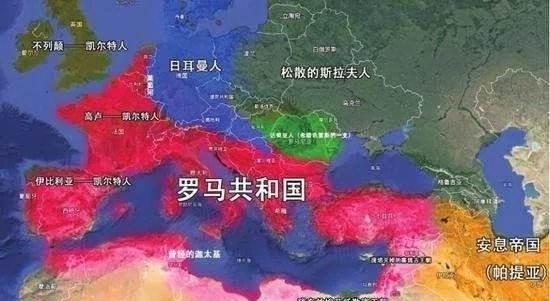The dynastic changes in ancient China were extremely clear, but not in other civilizational regions of the world, such as the "Rome" discussed in this article.
What year did the Roman Empire begin? In fact, there is no such year in history as the name of our country, and no one has announced the birth of the Roman Empire.
In general, the history of Rome is divided into three stages:
Roman monarchy (753–509 BC)
Roman Republic (509–27 BC)
Roman Empire (27 BC – 476 AD/1453)

So, what happened in 27 BC? By this year, Octavian had defeated Antony as the final winner of the "Last Three".
Two years earlier, in 29 B.C., the triumphant Octavian had been granted the post of "" by the Senate, becoming the eternal supreme commander of the three armies of Rome.
A year earlier, in 28 B.C., Octavian had been granted the office of "" by the Senate, and the throne began to override all senators and consuls.
In this year 27 B.C., Octavian announced that he would resign from all his offices and that he would return to the hidden mountains. As a result, the Roman people praised Octavian's lack of lust for power, and the Senate was also very "moved", and greatly retained it, and granted Octavian a demigod honorific title - Augustus (sacred).
From then on, Augustus's name even surpassed his real name Octavian and became the title of Roman Emperor, and it is for this reason that this year is regarded as the beginning of the Roman Empire.
Four years later, in 23 BC, the Senate granted Octavian another title——, also known as "Führer", that is, from Octavian onwards, Rome entered the era of the Führer.
Is the Führer monarchy? Strictly speaking, it is not, it is still a republic, because the Senate and the Citizens' Assembly still exist, but their military, political, and financial power is gradually usurped by Octavian in various ways. We can say that the Führer established by Octavian was essentially a hidden monarchy cloaked in republican garb.
However, we can still see that the so-called Roman emperors starting from Octavian are indeed different from the kings of Eastern Persia and the emperors of our country, which have no royal authority and divine authority, nor are they the family world of the heirs.
During this period, the name of the Roman state was also no different from that of the Roman Republic, and it was "the Senate and the Roman people", that is, S.P.Q.R.
This situation began to change after the crisis of the third century.
<h1 class = "pgc-h-arrow-right" >1, Diocletian</h1>
When the Han Dynasty of our country collapsed, the Roman Empire in Europe also entered the "three-century crisis", with economic decline, political chaos, barbarian invasion, and the empire was in turmoil, just like our country.
Rome's decline during this period was due to a variety of reasons, but politically the immobilization of the heir system led to confusion in the succession of the empire to the throne, which was an important factor in the empire's precariousness.
When Diocletian ascended to the throne in 284 AD, he began to learn from the East, strengthened centralization, and changed his title from Führer to "Dominus", meaning "master", setting the precedent for the Absolute Monarchy of Rome.
Diocletian wore a crown and a purple robe with gold trim, modeled on the etiquette of the Persian Empire in the East, requiring subjects to kneel and pray when they visited. That is to say, from Diocletian onwards, the Roman Emperor also began to become a true monarch not only in substance but also in form, not just the "first citizen".
However, later Diocletian implemented the "four emperors co-governance system" on the empire, that is, dividing the empire into two parts, east and west, each part had an emperor, Augustine, and also had a deputy emperor, Caesar.
In fact, this system still could not change the chaotic situation of succession, so Diocletian was still a bloody battle for the throne.
And the victor was Constantine the Great.
<h1 class = "pgc-h-arrow-right" >2, Constantine the Great</h1>
In 323 AD, Constantine defeated all the challengers, reunified Rome, and became the only Augustus of the Empire.
Later, Constantine the Great continued to strengthen the absolute monarchy, abolishing Diocletian's four-emperor co-rule system and formalizing the monarchy. A clear sign is that the official documents of Rome began to appear "", and the name of this country is the famous "Roman Empire".
That is to say, from Constantine the Great, Rome officially changed from the fuehrer system to the monarchy of the East, Rome also officially became an empire, the "republic" was completely over, and Constantine the Great was the de facto first Roman Emperor.
In 330 AD, Constantine the Great moved the capital of the empire to Byzantium in the east, the new Rome, Constantinople, which reflected his intention to orientalize Rome and rely on the monarchy to solve the situation of Rome's constant chaos.
Prior to this, in 313 AD, Constantine the Great issued the "Edict of Milan", which formally recognized the legitimate status of Christianity in the Roman Empire.
On May 22, 337, Constantine the Great died, and he was baptized as a Christian on his deathbed.
These three achievements enabled Constantine the Great to surpass Octavian and become the most influential emperor in Roman history.
The Roman Empire consisted of many dynasties, and the dynastic changes were extremely frequent, but the "name of the country" never changed. If we compare our country with the Roman Empire, then we should compare it with the entire imperial era of our country from the Qin Dynasty to the Qing Dynasty.
The question is, who should be the Qin Shi Huang (establishing the territory) and the Han Wu Emperor (establishing the Confucian status) of the Roman Empire? I think that Caesar was the First Emperor of Qin in Rome, Octavian was equivalent to Liu Bang, and Constantine the Great was the Emperor Wu of Rome.